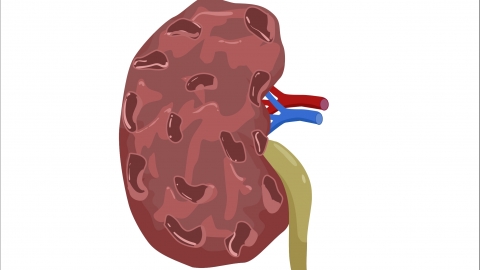What causes hematuria in polycystic kidney disease?
Generally, hematuria in patients with polycystic kidney disease may be caused by insufficient water intake, mental stress, rupture of capillaries on the cyst surface, pyelonephritis, chronic renal failure, and other factors. If discomfort occurs, timely medical attention is recommended. Detailed explanations are as follows:
1. Insufficient water intake
Long-term inadequate water intake can lead to concentrated urine, increasing the concentration of metabolic waste in urine and irritating the mucous membranes of the kidneys and urinary tract, which may cause hematuria in patients with polycystic kidney disease. It is important to develop the habit of drinking water regularly, ensuring a daily intake of 1500-2000 milliliters to maintain urine that is light yellow or colorless. Avoid replacing water with beverages and limit consumption of strong tea, coffee, and other stimulant drinks.
2. Mental stress
Long-term mental stress can affect the neuroendocrine regulation of the body, possibly leading to renal vasoconstriction and impaired kidney blood circulation, which may result in hematuria in polycystic kidney disease. Stress can be relieved through daily practices such as meditation, deep breathing exercises, and developing hobbies. When facing high-pressure situations, communicate promptly with family and friends, and seek professional psychological support if necessary.

3. Rupture of capillaries on the cyst surface
In patients with polycystic kidney disease, as kidney cysts continue to grow, the capillaries on their surfaces become fragile and prone to rupture and bleeding even with slight expansion or minor stimulation, leading to hematuria. Bed rest and reduced waist movement are recommended during bleeding episodes. Hemostatic medications such as adrenochrome tablets, aminobenzoic acid tablets, and thrombin lyophilized powder may be used under medical guidance. Additionally, avoid actions that may increase abdominal pressure, such as straining during bowel movements or severe coughing.
4. Pyelonephritis
Pyelonephritis is a common complication in patients with polycystic kidney disease. Bacterial infection causes inflammation of the renal pelvis, leading to congestion and edema of the renal mucosa, which can easily result in hematuria, often accompanied by symptoms such as fever, flank pain, and frequent urination. Antibiotics such as cefixime dispersible tablets, amoxicillin capsules, and norfloxacin capsules should be used under medical guidance. During treatment, ensure adequate rest, drink plenty of water to promote urine excretion and aid in recovery from inflammation, maintain personal hygiene, and avoid holding urine.
5. Chronic renal failure
As polycystic kidney disease progresses, kidney function gradually deteriorates into chronic renal failure. The filtration and reabsorption functions of the kidneys are severely impaired, allowing red blood cells to pass through the damaged glomerular filtration membrane into the urine, causing hematuria. This may also be accompanied by systemic symptoms such as nausea, vomiting, and fatigue. Medications to improve kidney function, such as compound α-keto acid tablets, Bailing capsules, and Jinshuibao capsules, should be used under medical guidance. Strictly follow a low-salt, low-protein diet, control protein intake, regularly monitor kidney function and electrolyte levels, and adjust treatment plans according to disease progression.
In daily life, maintain a regular routine, avoid excessive fatigue, engage in appropriate light exercise to enhance physical resistance, and undergo regular kidney ultrasound and urinalysis to closely monitor disease changes.





